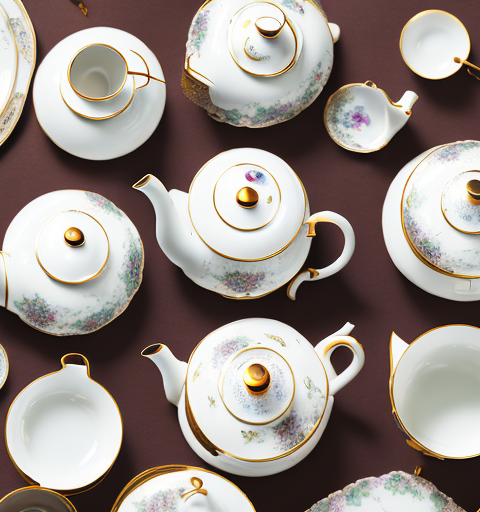Tea stains on the ceramic spout of a teapot with a wide opening can be quite a pesky problem. Whether you are an avid tea drinker or simply enjoy the occasional cup, it’s important to understand the nature of these stains and how to effectively remove them. In this article, we will explore the causes of tea stains on ceramic teapot spouts, assess the severity of the stain, and provide you with step-by-step instructions on how to remove them using different cleaning methods. We will also discuss natural remedies and commercial cleaning products that can help tackle stubborn tea stains. Additionally, we will share some maintenance tips to prevent future stains and offer expert advice on maintaining the aesthetic appeal of your teapot’s ceramic spout.
Understanding the nature of tea stains on ceramic surfaces
Tea stains on ceramic surfaces, including the spout of a teapot, are the result of tannins present in tea leaves. Tannins are natural compounds that can bind to porous materials, such as ceramic, and leave behind stubborn stains. These stains can be particularly noticeable on light-colored ceramic surfaces and can become more prominent over time if not properly addressed.
It is important to note that the temperature of the tea can also affect the severity of the stains. Hot tea can cause the tannins to bind more strongly to the ceramic surface, making the stains more difficult to remove. Additionally, the type of tea used can also impact the staining. Certain teas, such as black tea, contain higher levels of tannins and may result in more pronounced stains compared to lighter teas like green or white tea.
The importance of keeping your teapot’s spout clean and stain-free
Keeping your teapot’s spout clean and stain-free is essential not only for aesthetic reasons but also for the overall longevity and functionality of the teapot. Tea stains can not only be unappealing to the eye but can also affect the taste and aroma of your tea. Additionally, a stained spout may indicate that other parts of the teapot could also be affected, potentially compromising the quality of your tea. Therefore, regular cleaning and removal of tea stains from the ceramic spout is crucial for enjoying the perfect cup of tea.
One of the main reasons why it is important to keep your teapot’s spout clean and stain-free is to prevent the buildup of bacteria. Tea stains can provide a breeding ground for bacteria, which can contaminate your tea and potentially lead to health issues. By regularly cleaning and maintaining the spout, you can ensure that your tea remains safe and hygienic to consume.
In addition to bacteria, a dirty and stained spout can also affect the flow of the tea. Over time, tea residue and stains can accumulate in the spout, causing it to become clogged or restricted. This can result in a slower pour or even a complete blockage, making it difficult to pour your tea smoothly. By keeping the spout clean and free from stains, you can maintain a consistent and effortless pour, enhancing your tea-drinking experience.
Common causes of tea stains on ceramic teapot spouts
There are several common causes for tea stains on ceramic teapot spouts. These include:
- Repeated exposure to tea without proper cleaning in between uses
- Leaving tea to sit in the teapot for extended periods
- Using tea leaves or bags that release high amounts of tannins
- Prolonged exposure to hard water
- Inadequate rinsing after cleaning
Identifying the specific cause of the tea stains on your teapot’s ceramic spout can help you choose the most suitable method for their removal.
One additional cause of tea stains on ceramic teapot spouts is the use of abrasive cleaning materials. Scrubbing the spout with harsh brushes or abrasive sponges can cause scratches on the surface, making it more prone to staining.
Another common cause of tea stains on ceramic teapot spouts is the buildup of mineral deposits. Over time, minerals from the water used to brew the tea can accumulate on the spout, leading to discoloration and stains.
Assessing the severity of the tea stain on your teapot’s spout
Before diving into the cleaning process, it’s important to assess the severity of the tea stain on your teapot’s ceramic spout. This will help determine the most appropriate cleaning method and gauge the level of effort required to remove the stain effectively. Tea stains can vary in intensity, from light discoloration to dark, stubborn marks. Light stains may be easier to remove, while more severe stains may require additional steps or specialized cleaning products.
One way to assess the severity of the tea stain is to examine the color and depth of the stain. Light discoloration may appear as a faint brown or yellow tint, while darker stains can be almost black in color. Additionally, the depth of the stain can indicate how deeply it has penetrated the ceramic surface of the teapot’s spout.
Another factor to consider when assessing the severity of the tea stain is the age of the stain. Fresh stains may be easier to remove compared to older, set-in stains that have had time to dry and become more stubborn. It’s important to take note of how long the stain has been present on the teapot’s spout to determine the best approach for cleaning.
Choosing the right cleaning method for removing tea stains from a wide-opening ceramic spout
When it comes to removing tea stains from a wide-opening ceramic spout, you have several cleaning methods to choose from. The most suitable method will depend on the severity of the stain and the materials you have available. Here are a few common methods:
- Using a baking soda paste: Create a paste by mixing baking soda with water until it forms a thick consistency. Apply the paste to the stain, gently scrub with a soft brush or cloth, and rinse thoroughly.
- Using white vinegar: Soak a cloth or sponge in white vinegar and apply it to the tea stain. Let it sit for a few minutes, then scrub gently and rinse with water.
- Using lemon juice: Squeeze fresh lemon juice onto the stain, let it sit for a few minutes, and scrub gently with a soft brush or cloth. Rinse thoroughly afterward.
- Using a commercial ceramic cleaner: There are various commercial cleaning products specifically formulated for removing tea stains from ceramic surfaces. Follow the instructions provided by the manufacturer for best results.
Remember to always test the cleaning method on a small, inconspicuous area of the teapot’s spout before applying it to the entire stain to ensure it does not cause any damage or discoloration.
It is important to note that different types of tea stains may require different cleaning methods. For example, stubborn stains that have been left untreated for a long time may require a more intensive cleaning approach. In such cases, you may consider using a mixture of hydrogen peroxide and baking soda. Create a paste by combining these two ingredients, apply it to the stain, and let it sit for a few minutes before scrubbing and rinsing thoroughly. This method can be effective in breaking down tough tea stains.
Step-by-step guide to removing tea stains from a wide-opening ceramic spout
Now, let’s walk through a step-by-step guide on how to remove tea stains from a wide-opening ceramic spout:
- Assess the severity of the stain: Determine the intensity of the tea stain on the spout to select the appropriate cleaning method.
- Prepare the cleaning solution: Depending on the chosen method, create a paste using baking soda and water, soak a cloth or sponge in white vinegar, squeeze fresh lemon juice, or use a commercial ceramic cleaner.
- Apply the cleaning solution: Apply the chosen cleaning solution to the tea stain on the ceramic spout, ensuring full coverage of the affected area.
- Gently scrub the stain: Using a soft brush or cloth, gently scrub the stain in circular motions. Take care not to apply excessive pressure to avoid damaging the ceramic surface.
- Rinse thoroughly: After scrubbing, rinse the spout with water to remove any residue from the cleaning solution.
- Repeat if necessary: For stubborn stains, you may need to repeat the cleaning process or try an alternative method.
- Dry the teapot: Once the stain is removed and the spout is clean, thoroughly dry the teapot to prevent moisture-related issues or potential future staining.
It is important to note that different types of tea stains may require different cleaning methods. For example, black tea stains may be more stubborn and require a stronger cleaning solution, while green tea stains may be easier to remove.
In addition to regular cleaning, it is recommended to periodically deep clean the ceramic spout to prevent the buildup of tea stains. This can be done by soaking the spout in a mixture of warm water and white vinegar for a few hours, followed by scrubbing and rinsing as usual.
Exploring natural remedies for removing tea stains from a teapot’s ceramic spout
If you prefer natural remedies, there are a few options to explore for removing tea stains from a teapot’s ceramic spout:
- Baking soda and water paste: As mentioned earlier, creating a paste using baking soda and water can effectively remove tea stains.
- White vinegar: Soaking a cloth or sponge in white vinegar and applying it to the stain can also provide good results.
- Lemon juice: The natural acidity in lemon juice can help break down tea stains. Apply fresh lemon juice to the stain and scrub gently.
These natural remedies are often readily available and can be effective in removing tea stains while being gentle on the ceramic surface.
Another natural remedy to consider is using salt. Salt can act as an abrasive and help scrub away tea stains. Simply sprinkle some salt onto a damp cloth or sponge and gently rub the stained area.
If you’re looking for a more powerful natural remedy, you can try using hydrogen peroxide. Hydrogen peroxide is a mild bleaching agent and can help lighten tea stains. Apply a small amount of hydrogen peroxide to a cloth or sponge and gently dab it onto the stain. Allow it to sit for a few minutes before rinsing it off.
Effective commercial cleaning products for tackling stubborn tea stains on ceramic surfaces
If natural remedies do not successfully remove stubborn tea stains, there are commercial cleaning products specifically designed for tackling such issues. These products usually contain powerful ingredients that can help break down and lift tea stains from ceramic surfaces. When selecting a commercial cleaner, look for one that is suitable for use on ceramic and follow the instructions provided by the manufacturer carefully.
One popular commercial cleaning product for removing tea stains on ceramic surfaces is a ceramic cleaner that contains citric acid. Citric acid is known for its ability to dissolve tough stains and can be effective in breaking down tea residue. Simply apply the cleaner to the stained area, let it sit for a few minutes, and then scrub gently with a sponge or brush. Rinse thoroughly with water to remove any residue.
Another option is to use a specialized stain remover specifically formulated for ceramic surfaces. These stain removers often contain enzymes or surfactants that can effectively break down and remove tea stains. Apply the stain remover to the affected area, let it sit for the recommended amount of time, and then wipe away with a clean cloth or sponge. Be sure to follow the instructions provided by the manufacturer for best results.
Preventing future tea stains on your teapot’s ceramic spout with simple maintenance tips
Prevention is always better than cure when it comes to tea stains on your teapot’s ceramic spout. Here are some simple maintenance tips to help prevent future stains:
- Regular cleaning: After each use, rinse the teapot’s spout thoroughly with warm water. If necessary, use a soft brush to remove any residue.
- Avoid prolonged exposure: Avoid leaving tea sitting in the teapot for extended periods, as this can increase the likelihood of stains.
- Use filtered water: If you have hard water in your area, consider using filtered water to reduce the mineral buildup that can contribute to stains.
By implementing these maintenance tips, you can keep your teapot’s ceramic spout free from tea stains and maintain its pristine appearance.
Additionally, it is important to note that using a teapot with a built-in strainer can also help prevent tea stains on the ceramic spout. The strainer will catch any loose tea leaves, preventing them from entering the spout and causing stains. When choosing a teapot, look for one with a fine mesh strainer or a removable infuser that fits securely in the spout.
Dos and don’ts for cleaning a wide-opening ceramic teapot spout without causing damage
When cleaning a wide-opening ceramic teapot spout, it’s important to keep in mind a few dos and don’ts to avoid causing any damage:
- Do use a soft brush or cloth: Opt for a soft brush or cloth when scrubbing the stain to avoid scratching or damaging the ceramic surface.
- Do test cleaning methods: Always test any cleaning method on a small, inconspicuous area of the spout before applying it to the entire stain.
- Do rinse thoroughly: After cleaning, make sure to rinse the spout thoroughly with water to remove any residue from the cleaning solution.
- Don’t use abrasive cleaners: Avoid using abrasive cleaners, such as scouring pads or strong chemicals, as they can cause damage to the ceramic surface.
- Don’t apply excessive pressure: Gentle scrubbing is sufficient to remove tea stains. Applying excessive pressure can lead to scratches or other damage.
By following these dos and don’ts, you can safely and effectively remove tea stains from your teapot’s wide-opening ceramic spout.
Expert advice on maintaining the aesthetic appeal of your teapot’s ceramic spout
To maintain the aesthetic appeal of your teapot’s ceramic spout, it is recommended to:
- Avoid using abrasive cleaning tools: Abrasive tools can scratch or damage the ceramic surface, compromising its appearance. Stick to soft brushes or cloths.
- Regularly inspect and clean the spout: Take the time to inspect the spout for any stains or buildup and clean it promptly to prevent stains from becoming harder to remove.
- Store the teapot properly: When not in use, ensure that the teapot is stored in a clean, dry place away from moisture or potential sources of staining.
Following these expert tips will help you maintain the aesthetic appeal of your teapot’s ceramic spout and ensure it remains a beautiful and functional addition to your tea-drinking experience.
In conclusion
Removing tea stains from the ceramic spout of a teapot with a wide opening is a manageable task with the right knowledge and techniques. By understanding the nature of tea stains, assessing their severity, and choosing the appropriate cleaning method, you can effectively remove these stains and ensure your teapot’s spout remains clean and stain-free. Whether you opt for natural remedies or commercial cleaning products, it’s important to follow the dos and don’ts to prevent any damage. By implementing simple maintenance tips and expert advice, you can enjoy a pristine and visually pleasing teapot spout for many cups of tea to come.






